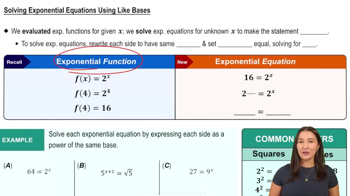Table of contents
- 0. Review of Algebra4h 16m
- 1. Equations & Inequalities3h 18m
- 2. Graphs of Equations43m
- 3. Functions2h 17m
- 4. Polynomial Functions1h 44m
- 5. Rational Functions1h 23m
- 6. Exponential & Logarithmic Functions2h 28m
- 7. Systems of Equations & Matrices4h 6m
- 8. Conic Sections2h 23m
- 9. Sequences, Series, & Induction1h 19m
- 10. Combinatorics & Probability1h 45m
6. Exponential & Logarithmic Functions
Solving Exponential and Logarithmic Equations
Problem 96
Textbook Question
Textbook QuestionIn Exercises 93–102, solve each equation. 3|log x|−6=0
 Verified Solution
Verified SolutionThis video solution was recommended by our tutors as helpful for the problem above
Video duration:
4mPlay a video:
Was this helpful?
Key Concepts
Here are the essential concepts you must grasp in order to answer the question correctly.
Logarithmic Functions
Logarithmic functions are the inverses of exponential functions and are defined for positive real numbers. The logarithm log_b(a) answers the question: 'To what exponent must the base b be raised to produce a?' Understanding how to manipulate and solve equations involving logarithms is crucial for solving logarithmic equations.
Recommended video:

Graphs of Logarithmic Functions
Absolute Value
The absolute value of a number is its distance from zero on the number line, regardless of direction. It is denoted as |x| and is always non-negative. In the context of logarithmic equations, recognizing how absolute values affect the solutions is essential, especially when dealing with log expressions that can yield both positive and negative results.
Recommended video:

Parabolas as Conic Sections Example 1
Algebraic Manipulation
Algebraic manipulation involves rearranging and simplifying equations to isolate variables. This includes operations such as adding, subtracting, multiplying, and dividing both sides of an equation. Mastery of these techniques is necessary to solve equations effectively, particularly when dealing with logarithmic and absolute value expressions.
Recommended video:
Guided course

Introduction to Algebraic Expressions

 4:46m
4:46mWatch next
Master Solving Exponential Equations Using Like Bases with a bite sized video explanation from Callie
Start learningRelated Videos
Related Practice













